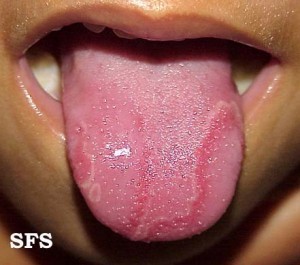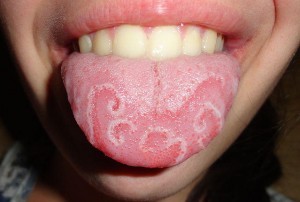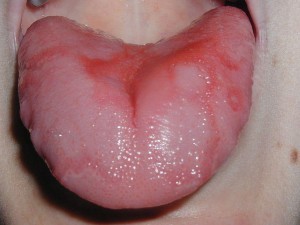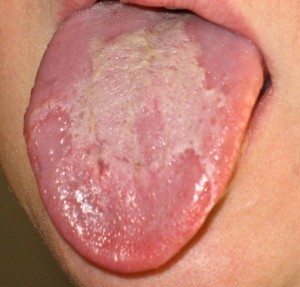Geographic Tongue Causes, Pictures, Treatment
We all expect to see a tongue of consistent color and texture when we look at it. Apart from the furry coating that develops during the day and is removed after brushing, the upper surface of the tongue has no noticeable variations in appearance. However, in people with a geographic tongue there are distinct irregular patches on the tongue that resemble a map with “islands”.
What is geographic tongue?
Geographic tongue is a condition where the tongue surface appears altered or abnormal. It is a harmless condition and most people never have any symptoms beyond the physical appearance of the tongue. The term geographic tongue is used because its describes what appears to small “islands” on the tongue surface, similar to a map. These islands can change in size and location over time.
Another term for geographic tongue is benign migratory glossitis. While glossitis infers inflammation of the tongue, there may be no significant inflammation in geographic tongue which is accompanied by other sensations like burning, pain or loss of taste. Despite the appearance of the tongue, it is not a serious condition and not usually associated with infections, autoimmune diseases or cancer.
Causes of Geographic Tongue
Normally the surface of the tongue has tiny projections, known as papillae, which gives it a rough texture. These papillae contain taste buds. The tongue is naturally pink due to the underlying blood flow of this muscular organ. A white furry coating may develop daily which is composed of tiny food particles, saliva and bacteria. This coating is easily removed with proper orodental hygiene like brushing the tongue.
In geographic tongue, the surface of the tongue is altered. There are tiny spots or patches where the papillae is absent. Although it mainly occurs on the top surface of the tongue, patches may also arise elsewhere in the mouth. The reason why these patches arise is unclear. A genetic link is suspected since there is often a family history of geographic tongue. There also appears to be a link with psoriasis but the exact mechanism is still unclear.
Most of the time geographic tongue is seen in middle-aged and older adults but can affect anybody of any age. It affects less than 1 in 20 people and women are more frequently afflicted compared to men. It is important to note that geographic tongue is not caused by eating spicy food or alcohol consumption, although these substances can aggravate additional symptoms like tongue discomfort when present.
Signs and Symptoms
Apart from difference in physical appearance of the tongue, there are usually no other symptoms. The patches in geographic tongue are irregularly shaped, similar to a map. It is smooth, red and varies in size, shape and location. Patches may persist for anywhere from a few days to several months before disappearing and other patches form elsewhere. The border of the patch is raised and is red or white in color.
Some people do experience discomfort, a burning sensation or even pain on the patches. However, this only affects about 1 in 10 people with geographic tongue. The sensitivity of the patches may only be detected when consuming hot, spicy or acidic foods, with tobacco chewing or when using toothpaste. In a minority of cases there may be a slight exacerbation of these symptoms with hormonal changes. When other symptoms appear, like bleeding or ulcers, then the condition may not be a geographic tongue.
Despite a geographic tongue being harmless, some people find it embarrassing or remain concerned that there is a more serious underlying condition like mouth cancer causing the patches. This can cause psychological stress. People who are overzealous may try to brush the tongue aggressively or use other measures that may can injury and even damage to the tissue of the tongue, result in pain and affecting the taste sensation.
Pictures of Geographic Tongue
It is important to remember that many tongue conditions may present with various lesions such as ulcers, growths and fissures which is entirely different from the lesions seen with a geographic tongue. Although the condition is harmless it is always advisable to have a geographic tongue examined by a medical practitioner for confirmation of the diagnosis.
Images sourced from Dermatology Atlas Brazil³ and Wikmedia Commons.
Other Tongue Conditions
There are various other tongue conditions which appear similar to a geographic tongue or are mistaken for a geographic tongue. This includes:
- Chemical burns on the tongue
- Oral candidiasis (mouth thrush)
- Fissured tongue
- Lichen planus
- Contact stomatitis
- Oral cancer
Apart from physical examination, no further diagnostic investigations are usually conducted for a geographic tongue. A biopsy may be performed in cases where other diseases or disorders are suspected and need to be ruled out. The sample is then sent to a laboratory for further microscopic examination. A biopsy is considered as a conclusive diagnosis and once a geographic tongue is confirmed, patients should rest assure that the tongue lesions are not due to any other serious condition.
Treatment and Prevention
Since a geographic tongue is harmless and usually does not present with other symptoms, there may be no need for any medical treatment. However, there has been some success reported with immune-suppressing drugs such as cyclosporine and corticosteroids. Antihistamines may also be useful. Usually medication is considered when there are other symptoms like burning and pain.
Apart from the drugs mentioned, a tender, burning or painful tongue may also require anti-inflammatory drugs or anesthetic mouth washes. As yet there is no specific way to prevent a geographic tongue. People who are experiencing symptoms like discomfort or pain should avoid spicy and acidic foods, stop cigarette smoking and change toothpastes to one that is less likely to trigger symptoms.
Never attempt to brush the patches vigorously. This can injure the tongue which is delicate and may lead to complications such as infections. Also ensure that dentures are properly fitting as this can cause tongue injury on a repeated basis although this does not lead to a geographic tongue. Nutritional supplementation is not necessary unless there is a deficiency although zinc supplementation may be beneficial to a slight degree.







